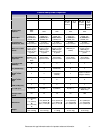Energy Efficiency
The cost of power has become a huge component of IT operating budgets all around the world. Many clients are facing
the critical issue of providing sufficient power and cooling to support their highly dense data center. Clients are demanding
solutions that allow them to get their work done, while fitting into an affordable power and cooling envelope. IBM considers
energy efficiency and addressing global climate change to be not only a decision that makes economic sense, but also
one of the most pertinent issues facing the planet at this time. The good news is that an important part of the solution to
these issues is available—it’s IBM BladeCenter.
BladeCenter is designed from the ground up to dramatically improve power utilization and reduce energy costs. In fact,
aggregate power savings of BladeCenter vs. 1U servers and related external equipment can be as much as 30-40%. This
can be attributed to a well-planned system architecture that includes more energy-efficient power supplies and thermals,
along with a super-smart power delivery solution. With IBM BladeCenter you get:
• Energy-efficient power supplies that operate at over 90 percent efficiency in converting AC power to DC power, compared to
an industry standard of 70 percent
• A shared-cooling approach that can lead to less power consumption by reducing the need for hundreds of fans for the blades
and switches
• The ability to add an integrated 10Gb Ethernet switch, which can be up to 95% more energy efficient than external switch
offerings
• IBM Systems Director Active Energy Manager for x86, a tool that can help you plan, predict, monitor and actively manage
power consumption of your BladeCenter servers
IBM BladeCenter should be part of an energy-efficient data center solution.
Storage
Data is the lifeline of today’s businesses. The integrity, availability and protection of data are vital to productivity and
success. Storing information is a requirement that’s shared by all types of businesses, from large enterprises to small
businesses and even single departments. Accordingly, managing data has become one of the biggest challenges
managers face today. Every year, the need for data storage capacity grows, with no end in sight.
As you consolidate your IT with BladeCenter, you can also consolidate your storage environments. With BladeCenter, the
storage fabric is included in the chassis. In fact, IBM was the first blade vendor to integrate the storage fabric into a blade
server architecture. By integrating the storage fabric into the BladeCenter chassis, you can potentially realize a significant
reduction in small form factor pluggable (SFP) cards and optical fiber cable costs and increase storage utilization.
It can be much more cost-effective and easier to manage BladeCenter when it is connected to external storage. IBM
delivers a wide range of easy-to-install, tested external storage products to meet your demanding business needs.
• Network-attached storage (NAS) — IBM System Storage
™
N series NAS products provide a large capacity, highly available
and secure environment for storing mission-critical data. The N series attaches to BladeCenter using integrated Gigabit
Ethernet switch modules.
• Storage area network (SAN) — IBM System Storage DS3000
™
, DS4000
™
, DS6000
™
, and DS8000
™
series provide
integrated SMB and enterprise solutions with multi-protocol local, campus, metropolitan and global storage networking. The
DS portfolio attaches to BladeCenter using Fibre Channel switch modules.
• iSCSI — BladeCenter offers both a 1Gb hardware and a 1Gb and 10Gb software iSCSI initiator. Both support iSCSI boot.
The iSCSI hardware initiator is an adapter with an embedded processor. This solution is beneficial for clients who don’t want
their server performance impacted. The iSCSI software initiator is embedded in the blade server BIOS and enables iSCSI
boot through a standard 1Gb Ethernet connection without the need for an adapter. This is an attractive, lower-cost alternative
for clients moving their storage off the blade and is available to BladeCenter clients at no charge. The iSCSI software initiator
also enables iSCSI boot through a standard 10Gb Ethernet connection with the NetXen 10Gb adapter. HP and Dell do not
offer a software iSCSI initiator. The IBM System Storage N series supports iSCSI server attachment.
• Fibre Channel — BladeCenter integrates the storage switches from vendors such as Brocade, Cisco and QLogic. And
BladeCenter supports industry-leading Fibre Channel host bus adapters from QLogic and Emulex. These options work well
with the IBM System Storage DS3400 and DS4000 series. IBM data tells us that more than 40% of BladeCenter users attach
their blades to a SAN. This is likely due to the wide selection and cost savings associated with integrated Fibre Channel.
Who Should Consider Blade Servers vs. Rack Servers
Consider blade servers if you:
• Plan to buy or replace six or more servers within the next twelve months
• Wish to set up a durable, long-term IT infrastructure that will grow with you
• Are running applications like Web serving and online commerce, networking, e-mail consolidated file and print, along with
large-scale database applications like data warehousing
• Run high-performance computing (HPC) applications such as digital signal processing, bioinformatics, seismic modeling,
crash simulations or digital rendering
• Have old Intel/AMD or SPARC processor-based servers suffering from poor availability and performance, lack of floor space,
limited power and cooling capabilities in your data center, and difficulty keeping track of and managing servers
• Are transitioning from UNIX
®
to Linux
®
• Currently use AIX
®
• Currently use Solaris 10 or plan to move to Solaris 10 on x86 architectures
Please see the Legal Information section for important notices and information.
35.


















